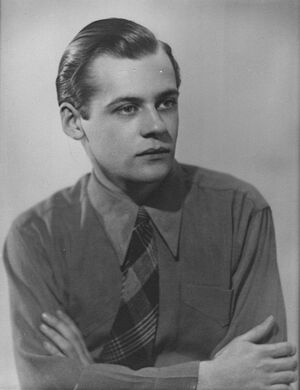Pierre Mercure facts for kids
Pierre Mercure (born February 21, 1927 – died January 29, 1966) was a very creative Canadian artist from Quebec. He was a composer (someone who writes music), a TV producer, a bassoon player, and he also helped manage arts organizations.
Contents
Early Life and Learning Music
Pierre Mercure was born in Montreal, Canada. He loved music from a young age. He studied at the Conservatoire de musique du Québec à Montréal. This is a famous music school.
He was a brilliant student. In 1949, he won top awards. He earned a "Premier prix" for harmony and counterpoint. He also got a "Deuxième prix" for playing the bassoon.
His main music teacher was Claude Champagne. Pierre also learned from other famous teachers. He studied with Nadia Boulanger in Paris. He also learned from Luigi Dallapiccola at a place called Tanglewood.
His Musical Journey
Pierre Mercure started his career by writing music for ballets. Ballets are dance performances with music. He wrote four ballets between 1948 and 1950.
He then started composing other types of music. This included music for orchestras, chamber groups (small groups of musicians), and even electronic music.
Pierre wanted to help Canadian music grow. He wanted it to be as good as music in Europe and the United States. He often traveled to France. There, he learned about new music styles.
Sadly, Pierre Mercure died young. He was only 38 years old. He passed away in a car accident in France.
His Compositions
Pierre Mercure wrote many different kinds of music. Here are some of his important works:
Ballet Music
- Dualité (1948)
- La Femme archaïque (1949)
- Lucrèce Borgia (1949)
- Emprise (1950)
- Improvisation (1961)
- Incandescence (1961)
- Structures métalliques I and II (1961)
- Tétrachromie (1963)
- Manipulations (1964)
- Surimpressions (1964)
Film Music
- Walls of Memory (Mémoire en fête) (1964)
- La Forme des choses (1965)
- Élément 3 (1965)
Orchestral Music
- Kaléidoscope (1948)
- Ils ont détruit la ville (1950)
- Cantate pour une joie (1955)
- Divertissement (1957)
- Triptyque (1959)
- Lignes et points (1964)
Chamber Music
- Pantomime (1948)
- H2O per Severino (1965)
Electronic Music
- Jeu de hockey (1961)
- Répercussions (1961)
- Structures métalliques III (1962)
- Psaume pour abri (1963)


